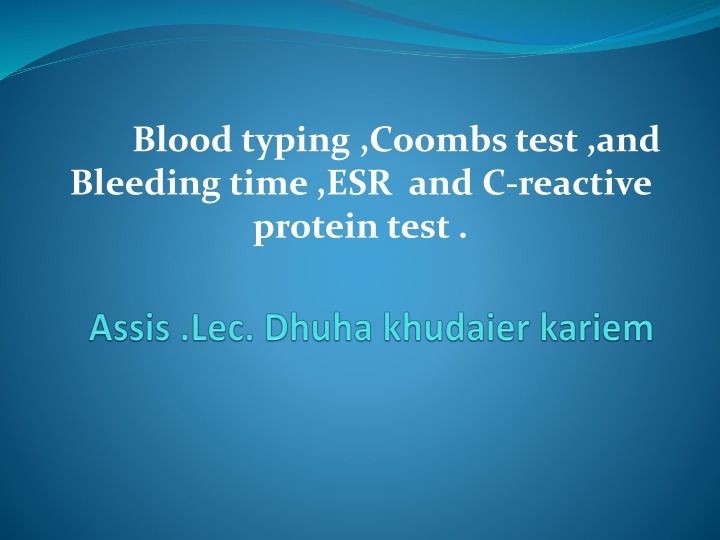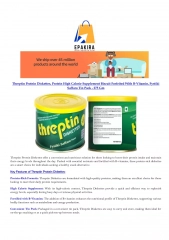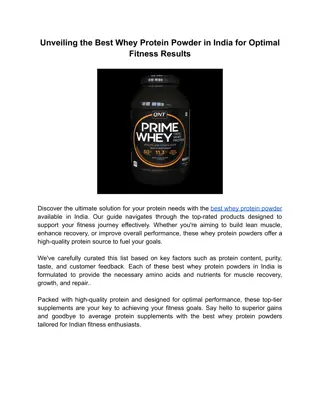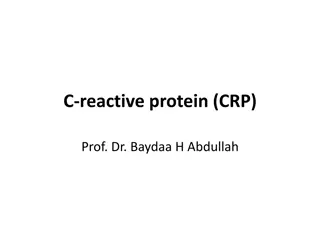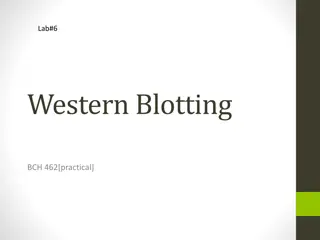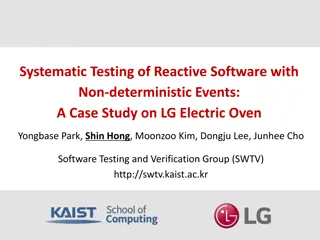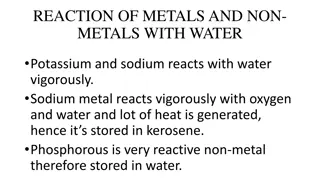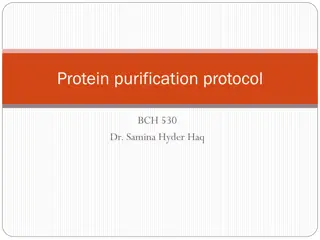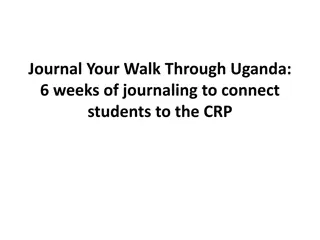C-Reactive Protein (CRP) Test
C-reactive protein (CRP) is a liver-produced protein that rises in response to inflammation. The CRP test assesses acute infections or inflammatory conditions and aids in post-surgery infection detection, inflammation monitoring in diseases like IBD and rheumatoid arthritis, and treatment response tracking for cancer or infections. The CRP test, a qualitative slide agglutination test using latex particles coated with anti-CRP antibodies, helps differentiate bacterial and viral infections. Its rapid detection of CRP in human serum enables quick assessment of inflammatory conditions and treatment efficacy.
Download Presentation

Please find below an Image/Link to download the presentation.
The content on the website is provided AS IS for your information and personal use only. It may not be sold, licensed, or shared on other websites without obtaining consent from the author.If you encounter any issues during the download, it is possible that the publisher has removed the file from their server.
You are allowed to download the files provided on this website for personal or commercial use, subject to the condition that they are used lawfully. All files are the property of their respective owners.
The content on the website is provided AS IS for your information and personal use only. It may not be sold, licensed, or shared on other websites without obtaining consent from the author.
E N D
Presentation Transcript
Blood typing ,Coombs test ,and Bleeding time ,ESR and C-reactive protein test .
C-reactive protein (CRP) C-reactive protein (CRP) is a special type of protein produced by the liver in response to inflammatory cytokines such as Interleukin-6 (IL-6). CRP is classified as an acute phase reactant, which means that its levels will rise within a few hours after tissue injury, the start of an infection, or other cause of inflammation. The most important role of CRP is its interaction with the complement system, which is one of the body s immunologic defense mechanisms
C-reactive protein (CRP) test is performed to determine if a person has a problem linked to acute infection or inflammation. The CRP test is not diagnostic of any condition, but it can be used together with signs and symptoms and other tests to evaluate an individual for an acuteorchronic inflammatorycondition. These include: To determine if there is infection after surgery: CRP levels normally increase within two to six hours following surgery but then return to normal by the third day; if CRP levels are elevated three days aftersurgery it means there is an infection. To keep track of an infection or disease that can cause inflammation: Inflammatory bowel disease (IBD), lymphoma, immune system diseases such as lupus (SLE), rheumatoid arthritis and osteomyelitis are some conditions in which inflammation can be monitored with a CRP test.
To monitor treatment of a disease such as cancer or infection: Not only do CRP levels go up quickly if you have an infection but they also return to normal quickly if you are responding to the treatment. An extremely elevated CRP is suggestive of a possible bacterial infection. Measures of CRP add to the diagnostic procedure in selected cases (e-g. in the differentiation between a bacterial and a viral infection). CRP Test is based on the introduced by Singer, et. al., in 1957. This is a slide agglutination test for the qualitative and semiquantitative detection of C- Reactive Protein (CRP) in human serum. Latex particles coated with goat IgG anti-human CRP are agglutinated when mixed with samples containing CRP. rapid latex agglutination method
The test is based on the reaction between patient serum containing CRP corresponding antibody coated to the treated surface of latex particle. The coated particles enhance the detection of an agglutinate reaction when antigen is present in the serum being tested. as the antigen & the
CRP Test Procedure (Qualitative) Bring all reagents and serum sample to Room Temperature and mix latex reagent gently prior to use. Do notdilute the controlsand serum. Place 1 drop each of serum, positive control and negativecontrol on separate reaction circles. Then add CRP latex reagent 1 drop to each of the circles. Mix with separate mixing sticks and spread the fluid overtheentire area of the cell. Tilt the slide back and forth slowly for 2 minutes observing preferably underartificial light.
CRP Test Procedure (Qualitative) Sera with positive results in the screening test should be retested in the semiquantitative test for obtaining the titre. Make serial two fold dilutions of the sample in 9 g/L saline solution. Proceed for each dilution as in the qualitative method. If controls do not give expected reactions the test is invalid and must be repeated. The titer, in semi-quantitative method, is defined as the highest dilution showing a positive result.
NOTE The reference range for C-reactive protein is : 0-10 mg/L High CRP concentration samples may give negative results .Re test the sample again using a drop of 20 l The strength of agglutination is not indicative of the CRP concentration in the samples tested. Clinical diagnosis should integrate both clinical an laboratory data. LIMITATIONS Reaction time is critical. If reaction time exceeds two minutes, drying of the reaction mixture may cause false positive results. Freezing the CRP Latex Reagent will result in spontaneous agglutination. phenomenon (antigen excess). It is recommended, therefore, to check all negative sera by retesting at a 1:10 dilution with Saline Solution.
ABO TYPING BY SLIDE METHOD PRINCIPLE A person s blood group is determined by testing the red blood cells with Anti-A and Anti-B agglutination of the test cells indicates the presence of the relevant antigen, while no agglutination indicates its absence. The following table shows the principle antigens and antibodies of the ABO system. Blood groups Antibodies regularly present in the serum Antigens on the RBCS O Neither A nor B Anti-A and Anti-B A A Anti-B B B Anti-A AB A and B None
ITEMS REQUIRED Equipment/ Materials Glass or plastic slides. Applicator sticks. Reagents Anti-A Anti-B Specimens EDTA Anticoagulated whole blood
TECHNICAL PROCEDURE Place 1 drop of Anti-A and 1 drop of Anti-B on a clean properly labeled glass or plastic slide. Add 1 drop of suspended RBCs to be tested to each drop of reagent. Suspend the RBCs in their own plasma, or the proper amount of blood may be transferred to the slid by the use of applicator sticks or dropper. Mix each drop thoroughly using separate applicator stick over area approximately 20min in diameter Rock the slides slowly for a period not exceeding two minutes. Read macroscopically for agglutination. Record test results. Procedure Note: Blood drawn into EDTA tube should not be stored for longer than 7 days. Test results must be interpreted immediately upon completion of the test. Extending the period before.
INTERPRETATIONS AND REPORTING RESULTS The reaction patterns of the most common ABO phenotypes are shown in the following table: Cell Grouping ABO Grouping Anti-A Anti-B + 0 A 0 + B 0 0 O + + AB
Coombs Test the Coombs test is one of the blood tests that help find out what kind of anemia you have. The Coombs test checks the blood to see if it contains certain antibodies that attack and destroy own red blood cells. If the red blood cells are being destroyed, this can result in a condition called hemolytic anemia. There are two types of Coombs tests: the direct Coombs test and the indirect Coombs test. The direct test is more common and checks for antibodies that are attached to the surface of your red blood cells. The indirect test checks for unattached antibodies that are floating in the bloodstream. It is also administered to determine if there was a potential bad reaction to a blood transfusion.
the Results for the Coombs Test Normal Results Results are considered normal if there is no clumping of red blood cells. Abnormal Results in a Direct Coombs Test It s an abnormal result if there is clumping of the red blood cells during the test. Clumping (agglutination) of blood cells during a direct Coombs test means present of antibodies on the red blood cells and that you may have a condition that causes the destruction of red blood cells by your immune system (hemolysis).
An abnormal result to an indirect Coombs test means you have antibodies circulating in your bloodstream that could cause your immune system to react to any red blood cells that are considered foreign to the body, particularly regarding those that may be present during a blood transfusion. Depending on your age and circumstances, this could mean a mother and infant have different blood types (erythroblastosisfetalis), an incompatible blood match for a blood transfusion, or hemolytic anemia due to an autoimmune reaction or drug toxicity. Infants with erythroblastosisfetalis may have very high levels of bilirubin in their blood, which leads to jaundice. This reaction occurs when the infant and mother have different blood types (Rh factor positive or negative, or ABO type differences), and the mother s immune system attacks the baby s blood during labor. This condition must be watched carefully because it can result in death of the mother and child. A pregnant woman is often given an indirect Coombs test to check for antibodies during prenatal care, before labor.
Coombs Test- Principle, Types, Procedure and Result Interpretation Coombs test is also known as antiglobulin test. The Coombs test tests for antibodies that may stick to the red blood cells and cause red blood cells to die too early. Coombs reagent is antihuman globulin. It is made by injecting human globulin into animals, which produce polyclonal antibodies specific for human immunoglobulins and human complement system factors. Principle of Coombs test Red cells coated with complement or IgG antibodies do not agglutinate directly when centrifuged. These cells are said to be sensitized with IgG or complement. In order for agglutination to occur an additional antibody, which reacts with the Fc portion of the IgG antibody, or with the C3b or C3d component of complement, must be added to the system. This will form a bridge between the antibodies or complement coating the red cells, causing agglutination.
Direct Coombs Test (Direct Antiglobulin Test- DAT) This is the test that is done on the newborn s blood sample, usually in the setting of a newborn with jaundice. The two most commonly recognized forms of antibody-mediated hemolysis in newborns are Rh incompatibility and ABO incompatibility
Procedure of Direct Coombs Test Prepare a 5 % suspension in isotonic saline of the red blood cells to be tested. With clean pipette add one drop of the prepared cell suspension to a small tube. Wash three times with normal saline to remove all the traces of serum. Decant completely after the last washing. Add two drops of Anti-human serum. Mix well and centrifuge for one minute at 1500 RPM. Resuspend the cells by gentle agitation and examine macroscopically and microscopically for agglutination.
Indirect Coombs Test (Indirect Antiglobulin Test- IAT) The indirect Coombs test looks for free-flowing antibodies against certain red blood cells. It is most often done to determine if you may have a reaction to a blood transfusion. This is the test that is done on the mother s blood sample as part of her prenatal labs. Frequently referred to as the antibody screen , this test identifies a long list of minor antigens that could either cause problems in the newborns or cause problems in the mother if transfusion is necessary.
Procedure of Indirect Coombs Test Label three test tubes as T (test serum) PC (Positive control) and NC (negative control). In the tube labelled as T , add two drops of Anti-D serum. In the tube PC add one drop of saline. Add one drop of 5 % saline suspension of the pooled O Rho (D) positive cells in each tube. Incubate all the three tubes for one hour at 37 C. Wash the cells three times in normal saline to remove excess serum with no free antibodies, (in the case of inadequate washings of the red cells, negative results may be obtained). Add two drops of Coombs serum (anti human serum) to each tube. Keep for 5 minutes and then centrifuge at 1,500 RPM for one minute. Resuspend the cells and examine macroscopically as well as microscopically.
Result Interpretation of Coombs Test Negative Result: No agglutination. This means you have no antibodies to red blood cells. Positive Result: Clumping (agglutination) of the blood cells during a direct Coombs test means that you have antibodies on the red blood cells and that you may have a condition that causes the destruction of red blood cells by your immune system (hemolysis). This may be due to Hemolytic anemia, Chronic lymphocytic leukemia or similar disorder, Erythroblastosisfetalis (hemolytic disease of the newborn), Infectious mononucleosis, Mycoplasmal infection, Syphilis, Systemic lupus erythematosusand Transfusion reaction, such as one due to improperly matched units of blood. drug toxicity where you develop antibodies to your red blood cells; drugs that can cause this include cephalosporins (an antibiotic), levodopa (for Parkinson s disease), dapsone (antibacterial), nitrofurantoin (antibiotic), NSAIDs such as ibuprofen, and quinidine (heart medication). Sometimes, especially in older adults, a Coombs test will have an abnormal result even without any other disease or risk factors.
BLEEDING TIME Bleeding time depends on the integrity of platelets and vessel walls, whereas clotting time depends on the availability of coagulation factors. In coagulation disorders like haemophilia, clotting time is prolonged but bleeding time remains normal. Procedure: Duke s method: Sterilize the finger tip using rectified spirit and allow to dry. Make a sufficiently deep prick using a sterile lancet, so that blood comes out freely without squeezing. Note the time (start the stop-watch) when bleeding starts. Mop the blood by touching the finger tip with a filter paper. This is repeated every 15 seconds, each time using a fresh portion of the filter paper, till bleeding stops. Note the time (stop the stop-watch). It is seen that the blood stains on the filter paper get smaller to disappear finally when bleeding stops.
Bleeding time is the interval between the moment when bleeding starts and the moment when bleeding stops. Normal bleeding time (Duke s method) is into 4 minutes. Bleeding time is prolonged in purpuras, but normal in coagulation disorders like haemophilia. Purpurascan be due to 1. Platelet defects - Thrombocytopenic purpura. 1. Primary (Idiopathic) - Thrombocytopenic purpura 2. Secondary - Thrombocytopenic purpura 2. Vascular defects - Senile purpura Platelets are important in preventing small vessel bleeding by causing vasoconstriction and platelet plug formation.
CLOTTING TIME Clotting time is also prolonged in conditions like vitamin K deficiency, liver diseases, disseminated intravascular coagulation, overdosageof anticoagulants etc. Capillary tube method: (Wright s method) Under sterile precautions make a sufficiently deep prick in the finger tip. Note the time when bleeding starts (start the stop watch). Touch the blood drop at the finger tip using one end of the capillary tube kept tilted downwards. The tube gets easily filled by capillary action. After about two minutes start snapping off small lengths of the tube, at intervals of 15 seconds, each time noting whether the fibrin thread is formed between the snapped ends. Note the time (stopthe stop watch) when the fibrin thread is first seen. Discussion: Clotting time is the interval between the moment when bleeding starts and the moment when the fibrin thread is first seen. Normal value is 3to 10 minutes. Bleeding time and clotting time are not the same
